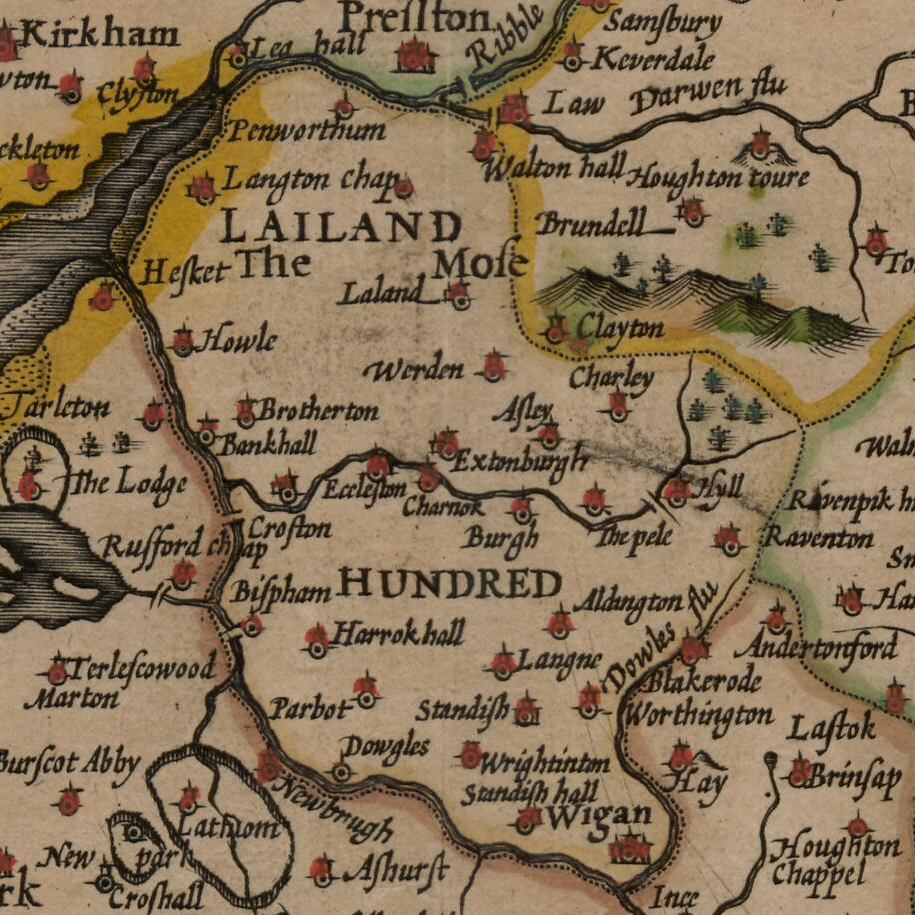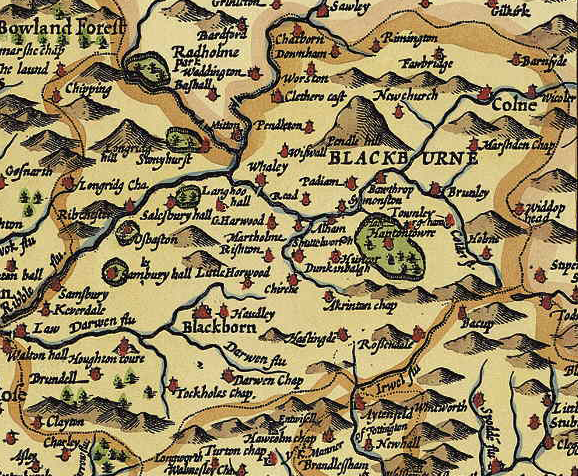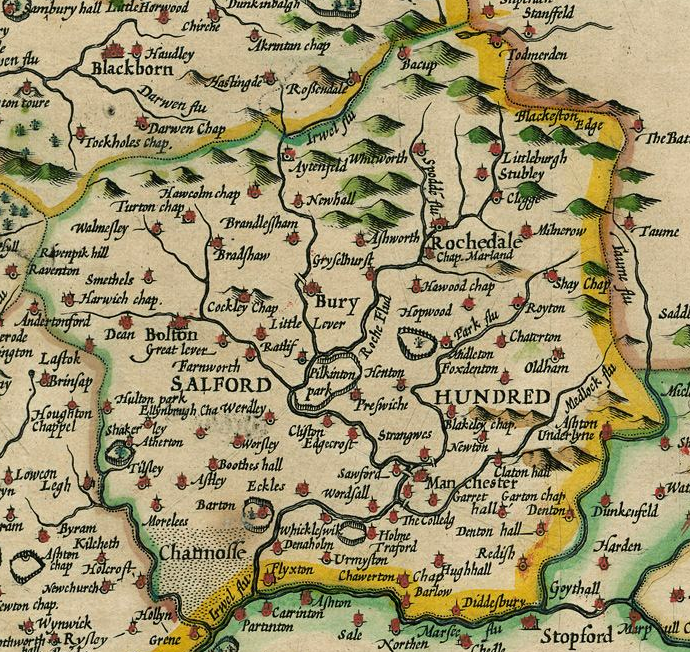|
Hundreds Of Cheshire
The Hundreds of Cheshire, as with other Hundreds in England, were the geographic divisions of Cheshire for administrative, military and judicial purposes. They were introduced in Cheshire some time before the Norman Conquest. Later on, both the number and names of the hundreds changed by processes of land being lost from Cheshire, and merging or amalgamation of remaining hundreds. The Ancient parishes of Cheshire were usually wholly within a specific hundred, although a few were divided between two hundreds. The hundreds at the time of the Domesday Survey Cheshire, in the Domesday Book was recorded as a larger county than it is today. There is a small disagreement in published sources about where the northern boundary of Cheshire lay, and some parts of the border areas with Wales were disputed with the predecessors of Wales. One source states that the northern border was the River Ribble, resulting in large parts of what was to become Lancashire being at that time part of Che ... [...More Info...] [...Related Items...] OR: [Wikipedia] [Google] [Baidu] |
Hundred (county Subdivision)
A hundred is an administrative division that is geographically part of a larger region. It was formerly used in England, Wales, some parts of the United States, Denmark, Sweden, Finland, Norway, and in Cumberland County, New South Wales, Cumberland County in the British Colony of New South Wales. It is still used in other places, including in Australia (in South Australia and the Northern Territory). Other terms for the hundred in English and other languages include ''#wapentake, wapentake'', ''herred'' (Danish and Bokmål, Bokmål Norwegian), ''herad'' (Nynorsk, Nynorsk Norwegian), ''härad'' or ''hundare'' (Swedish), ''Harde'' (German), ''hiird'' (North Frisian language, North Frisian), ''kihlakunta'' (Finnish), and ''cantref'' (Welsh). In Ireland, a similar subdivision of counties is referred to as a Barony (Ireland), barony, and a hundred is a subdivision of a particularly large townland (most townlands are not divided into hundreds). Etymology The origin of the division of ... [...More Info...] [...Related Items...] OR: [Wikipedia] [Google] [Baidu] |
Nantwich
Nantwich ( ) is a market town and civil parish in the unitary authority of Cheshire East in Cheshire, England. It has among the highest concentrations of listed buildings in England, with notably good examples of Tudor and Georgian architecture. At the 2021 census, the parish had a population of 14,045 and the built up area had a population of 18,740. History The origins of the settlement date to Roman times, when salt from Nantwich was used by the Roman garrisons at Chester (Deva Victrix) and Stoke-on-Trent as a preservative and a condiment. Salt has been used in the production of Cheshire cheese and in the tanning industry, both products of the dairy industry based in the Cheshire Plain around the town. ''Nant'' comes from the Welsh for brook or stream. '' Wich'' and '' wych'' are names used to denote brine springs or wells. In 1194 there is a reference to the town as being called ''Nametwihc'', which would indicate it was once the site of a pre-Roman Celtic nemeton ... [...More Info...] [...Related Items...] OR: [Wikipedia] [Google] [Baidu] |
Macclesfield
Macclesfield () is a market town and civil parish in the unitary authority of Cheshire East, Cheshire, England. It is sited on the River Bollin and the edge of the Cheshire Plain, with Macclesfield Forest to its east; the town lies south of Manchester and east of Chester. Before the Norman Conquest, Macclesfield was held by Edwin, Earl of Mercia and was assessed at £8. The Middle Ages, medieval town grew up on the hilltop around what is now St Michael's Church, Macclesfield, St Michael's Church. It was granted a municipal charter in 1261. King's School, Macclesfield, Macclesfield Grammar School was founded in 1502. The town had a silk-button industry from at least the middle of the 17th century and became a major Silk industry of Cheshire#Macclesfield, silk-manufacturing centre from the mid-18th century. The Macclesfield Canal was constructed in 1826–31. Hovis, Hovis breadmakers were another Victorian era, Victorian employer; modern industries include pharmaceutical indus ... [...More Info...] [...Related Items...] OR: [Wikipedia] [Google] [Baidu] |
Eddisbury (hundred)
The Hundreds of Cheshire, as with other Hundreds in England, were the geographic divisions of Cheshire for administrative, military and judicial purposes. They were introduced in Cheshire some time before the Norman Conquest. Later on, both the number and names of the hundreds changed by processes of land being lost from Cheshire, and merging or amalgamation of remaining hundreds. The Ancient parishes of Cheshire were usually wholly within a specific hundred, although a few were divided between two hundreds. The hundreds at the time of the Domesday Survey Cheshire, in the Domesday Book was recorded as a larger county than it is today. There is a small disagreement in published sources about where the northern boundary of Cheshire lay, and some parts of the border areas with Wales were disputed with the predecessors of Wales. One source states that the northern border was the River Ribble, resulting in large parts of what was to become Lancashire being at that time part of Chesh ... [...More Info...] [...Related Items...] OR: [Wikipedia] [Google] [Baidu] |
Bucklow (hundred)
The hundred of Bucklow was an ancient division of the historic county of Cheshire, in northern England. It was known to have been in existence at least as early as 1260, and it was formed from the earlier Domesday hundreds of Bochelau and Tunendune. Courts Courts, or Eyres, were normally held annually in the region, a week after the close of the county court. The Justice of Chester presided over the courts, and he would spend several days visiting each hundred in the region. On 13 October 1445 he held an Eyre at either Middlewich or Northwich for the Buckley and Northwich Hundreds, grouped together for convenience. Annual tourns were also held by the High Sheriff of Cheshire; on 26 September one such tourn was held for Bucklow Hundred in Hale. See also * Hundreds of Cheshire * Sir Peter Leycester, 1st Baronet Sir Peter Leycester, 1st Baronet (also known as Sir Peter Leicester) (3 March 1614 – 11 October 1678) was an English antiquarian and historian. He was in ... [...More Info...] [...Related Items...] OR: [Wikipedia] [Google] [Baidu] |
Broxton (hundred)
The Hundreds of Cheshire, as with other Hundreds in England, were the geographic divisions of Cheshire for administrative, military and judicial purposes. They were introduced in Cheshire some time before the Norman Conquest. Later on, both the number and names of the hundreds changed by processes of land being lost from Cheshire, and merging or amalgamation of remaining hundreds. The Ancient parishes of Cheshire were usually wholly within a specific hundred, although a few were divided between two hundreds. The hundreds at the time of the Domesday Survey Cheshire, in the Domesday Book was recorded as a larger county than it is today. There is a small disagreement in published sources about where the northern boundary of Cheshire lay, and some parts of the border areas with Wales were disputed with the predecessors of Wales. One source states that the northern border was the River Ribble, resulting in large parts of what was to become Lancashire being at that time part of Chesh ... [...More Info...] [...Related Items...] OR: [Wikipedia] [Google] [Baidu] |
Leyland (hundred)
The Leyland Hundred (also known as Leylandshire) is a historic subdivision of the English county of Lancashire. It covered the parishes of Brindle, Chorley, Croston, Eccleston, Hoole, Leyland, Penwortham, Rufford, Standish and Tarleton. In the Domesday Book the area was recorded as 'Lailand' Hundred, included in the returns for Cheshire Cheshire ( ) is a Ceremonial counties of England, ceremonial county in North West England. It is bordered by Merseyside to the north-west, Greater Manchester to the north-east, Derbyshire to the east, Staffordshire to the south-east, and Shrop .... However, it cannot be said clearly to have been part of Cheshire.Crosby, A. (1996). writes on page 31: Notes and references Bibliography *Crosby, A. (1996). ''A History of Cheshire.'' (The Darwen County History Series.) Chichester, West Sussex, UK: Phillimore & Co. Ltd. . *Harris, B. E., and Thacker, A. T. (1987). ''The Victoria History of the County of Chester. (Volume 1: Physiqu ... [...More Info...] [...Related Items...] OR: [Wikipedia] [Google] [Baidu] |
Blackburn (hundred)
Blackburn Hundred (also known as Blackburnshire) is a historic sub-division of the county of Lancashire, in northern England. Its chief town was Blackburn, in the southwest of the hundred. It covered an area similar to modern East Lancashire, including the current districts of Ribble Valley (excluding the part north of the River Ribble and east of the Hodder, which was then in Yorkshire), Pendle (excluding West Craven, also in Yorkshire), Burnley, Rossendale, Hyndburn, Blackburn with Darwen, and South Ribble (east from Walton-le-dale and Lostock Hall). Much of the area is hilly, bordering on the Pennines, with Pendle Hill in the midst of it, and was historically sparsely populated. It included several important royal forests. In the 18th century several towns in the area became industrialized and densely populated, including Blackburn itself, and Burnley. Early history The shire probably originated as a county of the Kingdom of Northumbria, but was much fought over. In th ... [...More Info...] [...Related Items...] OR: [Wikipedia] [Google] [Baidu] |
Salford Hundred
The Salford Hundred (also known as Salfordshire) was one of the subdivisions (a hundred) of the historic county of Lancashire in Northern England. Its name alludes to its judicial centre being the township of Salford (the suffix ''-shire'' meaning the territory was appropriated to the prefixed settlement). It was also known as the Royal Manor of Salford and the Salford wapentake.. Origins The Manor or Hundred of Salford had Anglo-Saxon origins. The ''Domesday Book'' recorded that the area was held in 1066 by Edward the Confessor. Salford was recorded as part of the territory of ''Inter Ripam et Mersam'' or "Between Ribble and Mersey", and it was included with the information about Cheshire, though it cannot be said clearly to have been part of Cheshire. The area became a subdivision of the County Palatine of Lancaster (or Lancashire) on its creation in 1182. Salford Hundred Court In spite of its incorporation into Lancashire, Salford Hundred retained a separate jurisdiction ... [...More Info...] [...Related Items...] OR: [Wikipedia] [Google] [Baidu] |
West Derby (hundred)
The West Derby Hundred (also known as West Derbyshire) is one of the six subdivisions of the historic county of Lancashire, in northern England. Its name alludes to its judicial centre being the township of West Derby (the suffix ''-shire'' meaning the territory was appropriated to the prefixed settlement). It covered the southwest of Lancashire, containing the ancient ecclesiastical parishes of Walton, Sefton, Childwall, Huyton, Halsall, Altcar, North Meols, Ormskirk, Aughton, Warrington, Prescot, Wigan, Leigh, Liverpool, and Winwick. It corresponds roughly to areas of Merseyside north of the River Mersey and also covered parts of modern West Lancashire Borough, Wigan borough, Warrington Borough and Halton Borough. History Domesday Book When the ''Domesday Book'' was compiled, this hundred was composed of three separate hundreds of West Derby, [...More Info...] [...Related Items...] OR: [Wikipedia] [Google] [Baidu] |





